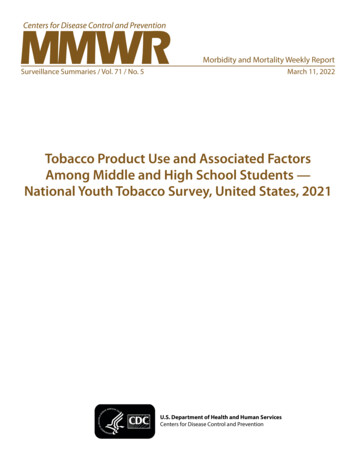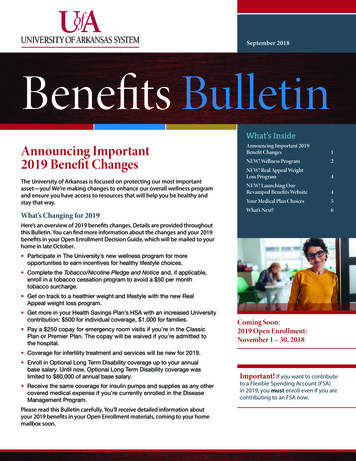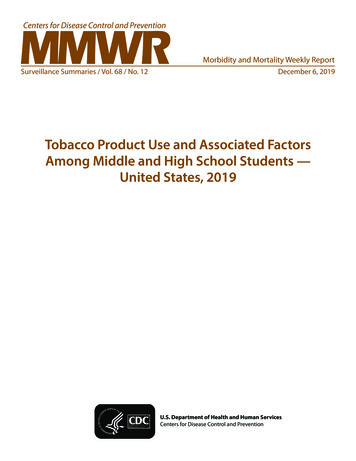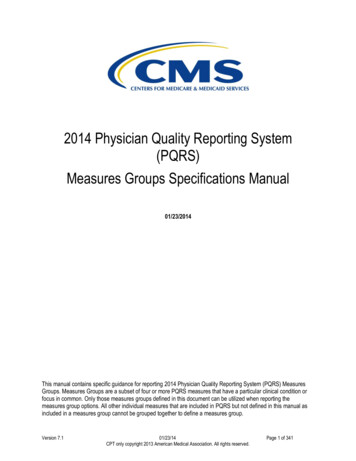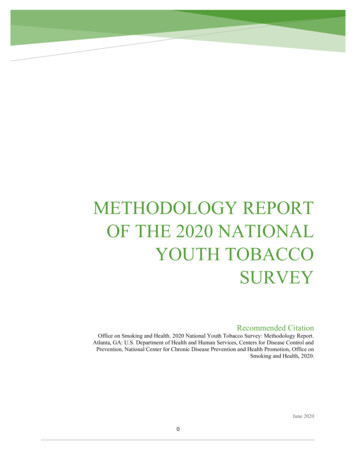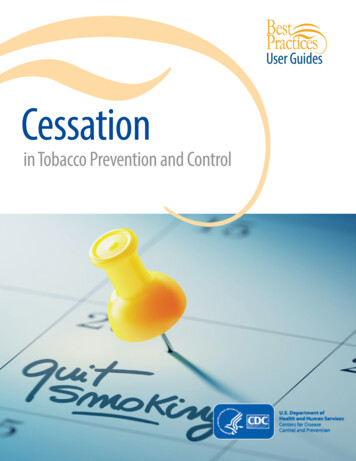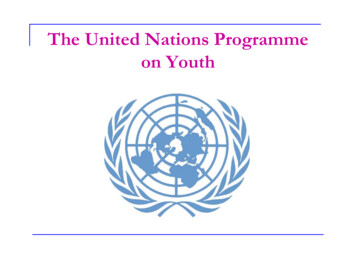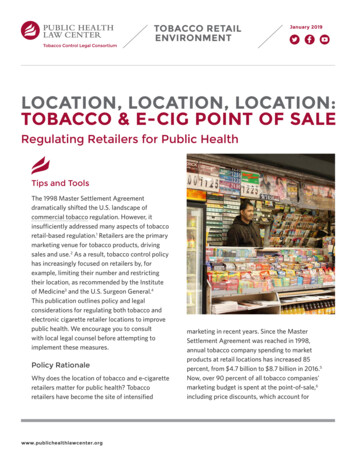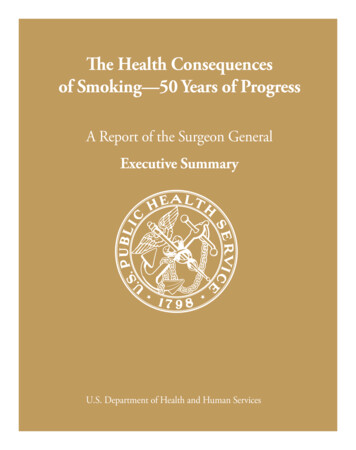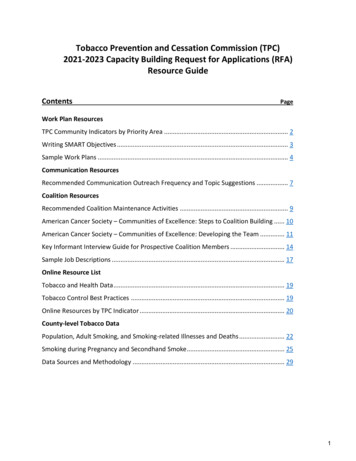
Transcription
A Report of the Surgeon GeneralPreventing Tobacco UseAmong Youth and Young AdultsMAKE THE NEXT GENERATION TOBACCO-FREE
Note From theU.S. Surgeon GeneralAbout This BookletNearly all tobacco use begins during youth and young adulthood. Tobacco containsnicotine, a highly addictive drug that causes many young people to progress fromsmoking occasionally to smoking every day.Each day across the United States, more than 3,800 youth under age 18 smoke theirfirst cigarette. Although much progress has been made to reduce the prevalence ofsmoking since the first Surgeon General’s report in 1964, today nearly one in four highschool seniors and one in three young adults under age 26 smoke.Regina M. Benjamin, M.D., M.B.A.Surgeon GeneralMost young people don’t consider the long-term health consequences associatedwith tobacco use when they start smoking. Because most high school smokers arenot able to break free from the powerful, addicting effects of nicotine, about three outof four will smoke in adulthood. Among those who persist in smoking, one third will dieabout 13 years earlier than their nonsmoking peers.This Surgeon General’s report details the causes and the consequences of tobacco useamong youth and young adults by focusing on the social, environmental, advertising,and marketing influences that encourage youth and young adults to initiate and sustaintobacco use. This is the first time tobacco data on young adults as a discrete populationhave been explored in detail. The report also highlights successful strategies to preventyoung people from using tobacco.This booklet summarizes the 2012 report and offers suggestions on how we can worktogether to protect youth and young adults from the harmful effects of tobacco. Weneed your help on this public health issue. Everything from making your home and cartobacco-free zones to demanding smoke-free policies in your community can make adifference. WE CAN make our next generation tobacco-free!The Surgeon General is America’s doctor. The President appoints the Surgeon General as the highest-ranking healthleader to protect the health of all Americans. The Surgeon General uses the strongest, most complete scientificinformation available to promote health, to reduce risk for illness and injury, and to make the nation healthier. Someof the Surgeon General’s most important tools are comprehensive scientific reports on specific health issues, suchas this report on tobacco use among youth and young adults. To read the full report and its related materials, go towww.surgeongeneral.gov.
What’s InsideThis BookletThis booklet contains highlights from the 2012 Surgeon General’s report on tobaccouse among youth and teens ages 12 through 17 and young adults ages 18 through 25.The first four pages are an overview of youth and young adult tobacco use, and thesections that follow provide details on health effects, factors that encourage youngpeople to use tobacco, the role of the tobacco industry, and what we can do to solvethe problem. For more information and additional resources, go to www.cdc.gov/tobacco.If you smoke and want to quit smoking, call 1-800-QUIT NOW (784-8669).Tobacco Use: A Preventable Epidemic.2The problem.2The causes.3The solutions.5Smoking and Health: They Just Don’t Mix.6Early smoking can cause early heart disease.6Early smoking can harm lungs now.6Smoking can lead to cancer.7Why Young People Use Tobacco. 8Social influences.8Physical influences.8Environmental influences.9Movies.9The Tobacco Industry.10Keeping prices down.10Making products easy to buy.10Designing products that appeal to youth.11Creating a package that appeals to youth.11Retail marketing.12Using media to promote products.12What We Can Do.13Policies and programs—which work best?.13Mass media campaigns.14Parents—how you can help.15Conclusion.16
Tobacco Use: A Preventable EpidemicTobacco use by teens and young adults remains shockingly high in the United States.Today, more than 3.6 million middle and high school students smoke cigarettes. Infact, for every person who dies due to smoking—more than 1,200 each day—at leasttwo youth or young adults become regular smokers. Nearly 90% of these replacementsmokers try their first cigarette by age 18. Clearly, we have not solved the problem.THE PROBLEMToday’s teens and young adults can accessinformation on millions of subjects almostinstantly. But many of the same media thatwarn of the dangers of tobacco use also carrymessages that smoking is cool—edgy—adult.That’s one reason nearly 4,000 kids under age18 try their first cigarette every day. That’salmost 1.5 million youth a year.In fact, nearly 9 out of 10 smokers startsmoking by age 18, and 99% start by age 26.On any given day, more than 2.500 youthand young adults who have been occasionalsmokers will become regular smokers. And atleast a third of these replacement smokers willdie early from smoking.The percentage of youth who smoke wentdown every year between 1997 and 2003.A REPORT OF THE SURGEON GENERAL 2
But since then, the decrease in teen smokinghas slowed and the use of some forms oftobacco by youth has leveled out. Today, oneout of four high school seniors and one out ofthree young adults under age 26 are smokers.THE CAUSESYoung people start using tobacco for manyreasons. These are some of the most important:The Tobacco IndustryFewer adults are smoking today, both becausemany have quit and because about half oflong-term smokers die from diseases causedby their tobacco use. So, cigarette companieslook to young people as replacement smokers.They use a variety of marketing strategies toencourage new consumers to try their products,and to continue using them.Susceptibility of Youth andYoung AdultsAdolescence and young adulthood are thetimes when people are most susceptible tostarting tobacco use. Young people are morevulnerable and more influenced by marketingthan adults. They are also more willing totake risks, even with their health. Whensmoking is portrayed as a social norm amongothers who are seen as cool, sophisticated,rebellious, or fun-loving, teens often respondby copying the behavior and trying cigarettesthemselves. If their friends smoke, or theirsiblings smoke, they are even more likely tosmoke themselves.Smoking causes disease and deathPeople who smoke don’t have to waitfor tobacco use to damage their health.There are more than 7,000 chemicals andchemical compounds in cigarette smoke,many of which are toxic. These chemicalscan cause immediate damage to thehuman body. Even young adults underage 30 who started smoking in their teensand early twenties can develop smokingrelated health problems, such as:Early cardiovascular disease.Smaller lungs that don’t function normally. heezing that can lead to a diagnosisWof asthma. NA damage that can cause cancerDalmost anywhere in the body.On average, lifelong smokers get sickerand die younger than nonsmokers. Thesesmokers die an average of 13 years sooner.WE CAN help teens and young adultssay no to tobacco.3 PREVENTING TOBACCO USE AMONG YOUTH AND YOUNG ADULTS
And young people are sensitive to nicotine.The younger they are when they start usingtobacco, the more likely they are to becomeaddicted to nicotine and the more heavilyaddicted they will become.Young people sometimes believe nothing canhurt them. Facts about health problems thatcould happen in middle age—or even rightaway—may mean little to them now. Manyteens and young adults don’t realize howaddictive nicotine is. Some may have a toughtime making healthy choices or sorting outtobacco myths from facts. Others may wantto fit in with a group or seem older, edgier,or more socially grounded. And images thatencourage tobacco use are everywhere—from the Internet to the movies to big, brightadvertisements at convenience stores. All ofthese factors make youth a prime market fortobacco products.Social NormsMany norms in our society influence youngpeople to try tobacco products. People smokein public in half of U.S. states because thereare no comprehensive smoke-free laws thatprohibit smoking at work sites, restaurants,and bars. Even states that prohibit smokinginside public buildings often have outdoorsmoking areas, some near schools and daycare centers. Tobacco use is prominent in massmedia, including in movies, social media,video games, and glossy magazines. Andtobacco advertising both inside and outsideretail stores is often the largest, most visibleadvertising for any product.A REPORT OF THE SURGEON GENERAL 4
If young people don’t start using tobacco by age 26,they almost certainly will never start.THE SOLUTIONSPrevention is critical. If young people don’tstart using tobacco by age 26, they almostcertainly will never start. The good news is thatthere are many things we can do to help keepteens and young adults tobacco-free. We can: reate a world where seeing peopleCsmoke or use other tobacco products isthe exception, not the norm. ake steps that make it harder for youthTto use tobacco, such as raising cigaretteprices and enforcing laws that prohibitthe sale of tobacco to children. urther limit tobacco marketing that isFlikely to be seen by young people. imit youth exposure to smoking inLmovies and other media.5 PREVENTING TOBACCO USE AMONG YOUTH AND YOUNG ADULTS ducate young people and help them makeEhealthy choices. et an example—encourage young peopleSto avoid tobacco use by quitting ourselves.For many decades, local and state healthdepartments, schools, and federal programshave taken steps to protect youth from tobaccouse. But in recent years, many of these effortshave been scaled back. We know what worksto keep young people tobacco-free, but wedon’t always do what is necessary. We havealready made some progress in reducingtobacco use by youth. Let’s finish what westarted and make the next generation tobaccofree. To learn more about steps to take, read“What We Can Do” on page 13.
Smoking and Health: They Just Don’t MixIt’s well known that smoking is bad for your health and causes many serious diseaseslater in life. In fact, one out of three adolescents who continue to smoke regularly will dieprematurely from cigarette smoking. But did you know that smoking can also harm youngsmokers’ health right away?EARLY SMOKING CAN CAUSE EARLYHEART DISEASENew research shows that smoking duringadolescence and young adulthood causesearly damage to the abdominal aorta, the largeartery that carries oxygen-rich blood from theheart through the abdomen to major organs.Even young adults who have only beensmoking for a few years can show signs ofnarrowing of this large artery. When a personbreathes tobacco smoke, it causes immediatedamage to blood vessels throughout the body.Repeatedly breathing tobacco smoke cancause a mixture of scar tissue and fats to buildup inside blood vessels. This plaque makesblood vessels narrow and limits blood flow.EARLY SMOKING CAN HARM LUNGS NOWYoung people are still growing. Their lungsdon’t reach full size until late teens for girlsand after age 20 for boys. Adults who smokedduring adolescence can have lungs that nevergrow to their potential size and never performat full capacity.A REPORT OF THE SURGEON GENERAL 6
Why is early smoking so harmful?People who start smoking as young teens aremore likely to: Get addicted to nicotine.Become lifetime smokers.Get diseases caused by tobacco use.Die from a disease caused by tobacco use.Photo courtesy of New York City Department of Health and Mental HygieneThe lungs of young smokers don’t performas well as those of nonsmokers. Becausetheir lungs don’t work as well, they areshort of breath and may have more troubleparticipating in sports and other physicalactivities. Even though people whostop smoking will improve their healthdramatically, early lung damage doesn’tgo away completely in most cases.SMOKING CAN LEAD TO CANCERTobacco smoke contains about 70 chemicalsthat can cause cancer. It’s no surprise, then,that smoking causes about one in three of allcancer deaths in the United States. And it cancause cancer almost anywhere in the body bydamaging DNA.Youth—a Great Time to QuitThe good news: Smokers who quit beforeage 30 will undo much of the health damagecaused by tobacco use.Why Is It So Hard to Quit?Tobacco users often get hooked onnicotine—the drug in cigarettes, cigars,and smokeless tobacco (snuff and chewingtobacco). Many teens and young adults planto quit using tobacco after a few years butfind out too late how powerfully addictivenicotine can be. Like heroin and cocaine,nicotine acts on the brain and creates feelingsof pleasure or satisfaction. Young brains arestill developing. That may be one reasonmany teens feel dependent on tobacco afterusing it for only a short time.Quitting isn’t easy, but it can be done.Better yet—don’t start!Not starting is even better than quitting. Learnwhat risk factors to look for and how to helpyourself, your friends, or the young people inyour life stay tobacco-free (see page 13). Theirhealth depends on it!WE CAN help young people say noto tobacco use.7 PREVENTING TOBACCO USE AMONG YOUTH AND YOUNG ADULTS
Why Young People Use TobaccoThere are many reasons young people begin using tobacco. Teenagers, and evenpreteens, are developing behaviors, social connections, and attitudes. They oftenexperiment with different behaviors because they see these behaviors in peers theyadmire, in adults they hope to be like someday, or in media or entertainment idols.SOCIAL INFLUENCESAdolescents and young adults are verysusceptible to social influences. If they seetobacco use as a normal behavior becausetheir friends or family members use tobacco,young people are more likely to try tobaccothemselves.Teens and young adults highly value theirfriendships and want to fit in with their group.What their peers do—and especially what theleaders of their social groups do—can havea strong influence on what they do. Youngpeople whose friends smoke are much morelikely to smoke as well.PHYSICAL INFLUENCESNicotine is just as addictive as heroinand cocaine. Because they are sensitiveto nicotine, teens can feel dependent ontobacco sooner than adults. There is alsoevidence that genetics might make it moredifficult for some young people to quitsmoking once they have started.A REPORT OF THE SURGEON GENERAL 8
ENVIRONMENTAL INFLUENCESMOVIESTeens and young adults are sensitive to whatthey see and hear in the world around them.If they are exposed to images that portraysmokers as cool, attractive, rebellious, funloving, risk-taking, or other characteristicsthey admire, young people may want tosmoke, too. Such images are often foundin advertising displays at conveniencestores and other outlets that sell tobacco.Communities that allow the sale of cigarettesand other tobacco products near schools havehigher rates of youth tobacco use than docommunities that have tobacco-free zonesaround schools. If teens and young adultssee tobacco use in their homes or in publicplaces within their communities, these imagesencourage them to see smoking as a normalpart of adult behavior.For many years, tobacco companies paid studiosto have their products appear in movies. Eventhough this practice is no longer allowed, moviesfor youth, and even some movies for children,may include images of characters using tobacco.These images are powerful because they canmake smoking seem like a normal, acceptable, oreven attractive activity. Young people may alsolook up to movie stars, both on and off screen,and may want to imitate behaviors they see.Over time, the number of images of tobaccouse in movies has gone down. But movies stillcontain thousands of images of tobacco use thatare proven to encourage young people to startsmoking. In 2010, nearly a third of top-grossingyouth-rated movies—those with G, PG, or PG-13ratings—contained images of tobacco use.This is how many teens and young adults use tobacco today: 3 million high school students and 600,000 middle schoolstudents smoke cigarettes.1 in 3 young adults smokes cigarettes. 1 in 4 high school seniors smokes cigarettes.1 in 5 male high school seniors smokes cigars and 1 in 10uses smokeless tobacco. any young people use more than one type of tobacco. Among those who use tobacco, moreMthan half of high school males and nearly a third of high school females use more than onetobacco product. These products include cigarettes, cigars, and smokeless tobacco, such aschew and snus, a dry snuff in a small teabag-like sachet.WE CAN make tobacco use theexception, not the norm.9 PREVENTING TOBACCO USE AMONG YOUTH AND YOUNG ADULTS
The Tobacco IndustryTobacco companies use multiple methods and spend lots of money to convince youngpeople that using tobacco is OK—even attractive. Their business depends on getting theseyoung consumers to try—and to keep using—their products. Young people are responsiveto marketing, making them vulnerable to messages that encourage tobacco use.KEEPING PRICES DOWNMAKING PRODUCTS EASY TO BUYTobacco companies lower prices throughcoupons and other promotions so thatconsumers can afford to buy their products.Teens are especially sensitive to pricing.A number of laws limit face-to-face andvending machine sales of tobacco productsto young people. But there is less oversightonline. While most websites say buyers mustbe at least 18 years old, research found that15- and 16-year-olds were able to place orderssuccessfully. Nearly 8 out of 10 of thoseyoung people received their orders, and only1 out of 10 shipments required proof of age atthe time of delivery of the tobacco product.In 2008, cigarette makers spent nearly 10 billion to market their products. Muchof this spending— 6 out of every 7—wasused to pay for price cuts through coupons,sales, and giveaways. Similarly, smokelesstobacco makers spent about 3 out of every 4 of their 547 million marketing budget tokeep prices low.A REPORT OF THE SURGEON GENERAL 10
DESIGNING PRODUCTS THAT APPEALTO YOUTHCigarettes that appeal to new smokers areoften smoother and milder to improve tasteand reduce the body’s physical reaction tothe smoke. While flavored cigarettes arenow prohibited, the industry still puts fruitflavoring and other kid-friendly flavors inmany of their cigars. This is especially true forcigarette-sized cigars, which are now availablein many flavor varieties—such as grape andstrawberry—that youth find appealing in otherproducts. Many of these little cigars lookexactly like cigarettes with a darker wrapper.Many smokeless products are also flavored.These include chew and snuff—which comein a variety of forms—and new smokelessproducts, such as dissolvable tobacco. Allof these products can cause serious healthproblems and lead to nicotine addiction andfuture smoking. And tobacco companies arestill using different techniques to make manycigarette brands taste less harsh—especiallybrands that young people often use when theystart smoking.Young people sometimes usesmokeless tobacco products inplaces where cigarettes arebanned, such as schools.Snus (dry snuff in a pouch),and dissolvable smokelessproducts in particular,provide a discreet way forPhoto courtesy of Campaignyoung people to maintainfor Tobacco-Free KidsMyth: Smoking helps you lose weightMany young people, especially girls andyoung women, believe that smoking canhelp them lose weight. But studies showthat’s not true—young people who smokeare not thinner than those who don’t.Cigarette marketing encourages the myth thatsmoking causes weight loss. And it targetswomen with brand names that suggestthinness, as well as with long, thin cigarettes.their addiction to nicotine even when theycan’t smoke. In fact, most youth users of thesesmokeless products also smoke cigarettes.The biggest danger of these products is thatthey may introduce kids to nicotine, puttingthem at risk for nicotine addiction.CREATING A PACKAGE THAT APPEALSTO YOUTHPackaging has a powerful visual impact.Users come to associate certain brands withcertain qualities. Words on packages, suchas “slims” and “thins,” push the myth ofweight loss. Before they were banned, somewords (“low tar,” “light,” “mild”) falselysuggested safety. Studies show that colormakes a difference too. Smokers tend to thinkthat cigarettes in lighter-colored packs are“lighter” and safer than cigarettes in darkercolored packs—even when both packs containthe exact same cigarettes.WE CAN limit tobacco marketing toyoung people.11 PREVENTING TOBACCO USE AMONG YOUTH AND YOUNG ADULTS
Why the industry targets young peopleYoung people are a prime market for tobaccoproducts. With smoking among adults declining,tobacco makers need to replace long-termusers who have quit . . . or died. So the tobaccoindustry recruits replacement smokers fromyouth and young adults—the age groupsin which 99% of tobacco use begins.Young adults are a prime target for tobaccoadvertising and marketing. And messagesaimed at this age group also attract theattention of younger consumers—a plus forthe tobacco industry.RETAIL MARKETINGTobacco companies use many marketing andadvertising tools at stores that sell tobaccoproducts. Even the locations where tobaccoproducts are sold can have an impact ontobacco use by young people. For example,more cigarettes are sold in convenience storesthan in any other type of store, and 70% ofadolescents shop in convenience stores at leastonce a week—where they are more likely tobe exposed to prosmoking messages.For many years, the tobacco industry hasoffered sellers financial rewards and discountswhen they sell large volumes of their products.Some stores and gas stations place tobaccoproducts on or near checkout counters—avisible spot that may trigger impulse buying.They also run sales on tobacco products andplace vivid, eye-catching ads in windows andoutside their buildings. Ads inside the store aresometimes at eye level for preteen children,which research shows might influence them totry tobacco products later.USING MEDIA TO PROMOTE PRODUCTSThe tobacco industry uses media to promoteits products to young people. Here are someof the channels it uses.Digital MediaMany cigarette companies use websites topromote their products. Some of thesewebsites feature videos, games, coupons,and contests that may appeal to youth.Meanwhile, some young people are usingsocial networking channels (Facebook,Twitter, discussion forums, message boards,and YouTube videos) to sing the praises oftobacco, especially to their peers.MagazinesTobacco ads are not allowed on TVor on billboards. But they may stillbe found in mainstream magazinestargeted to adults, and manyyoung people read these.These ads often suggestthat using tobacco canmake you sexy, popular,thin, and cool.A REPORT OF THE SURGEON GENERAL 12
What We Can DoWORKING TOGETHER, WE CAN END THE TOBACCO EPIDEMIC.If we choose to, we can end the tobacco epidemic in this country. But it’s going totake all of us—parents, teachers, health care providers, communities, states, schools,and policymakers—supporting policies, programs, and media campaigns that preventtobacco use by youth and young adults.POLICIES AND PROGRAMS—WHICH WORK BEST?There are effective policies and programs thatprevent young people from using tobacco.Policies and programs that contain severalparts working together to make tobacco usemore difficult and less accepted are the onesthat work best.13 PREVENTING TOBACCO USE AMONG YOUTH AND YOUNG ADULTSPoliciesPolicies are very effective because they canchange the environment so that choosing atobacco-free life is encouraged and supported.Government and private entities haveimplemented a number of policies that areeffective in preventing youth tobacco use.
Who is at risk?Some youth are at higher risk for tobacco use. For example,young people are more likely to use tobacco if they: ave access to smoking areas and tobacco products—Hespecially to low-cost or free tobacco. Have friends, brothers, or sisters who use tobacco.Watch movies that have smoking in them. Are not doing well in school or have friends who arenot doing well in school. Are not engaged in school or religious activities. Use other substances, such as alcohol or marijuana.Here are some policies proven to work best: Make tobacco products less affordable.Restrict tobacco marketing. an smoking in public places—such asBworkplaces, schools, day care centers,hospitals, restaurants, hotels, and parks. equire tobacco companies to labelRtobacco packages with large, graphichealth warnings.ProgramsMany states and communities have programsto prevent tobacco use by young people. Themost effective ones combine several elements;include evidence-based curricula in secondaryschools; work with policies; and influencepeople at work, at home, in school, in healthcare settings, and in public places.MASS MEDIA CAMPAIGNSMass media campaigns against tobaccouse—most often TV ads—have provenvery effective at helping prevent tobaccouse by young people. Studies show thatteens respond most to ads that trigger strongnegative feelings, such as ads about howsmoking and secondhand smoke harm healthand ads that expose the tobacco industry’smarketing strategies that target youngpeople. Even ads that are designed for adultaudiences help reduce tobacco use amongyoung people.Every 3 or 4 years, new groups of childrenand teens reach the age where they arevulnerable to influences encouraging themto smoke. To be effective, mass mediacampaigns must be repeated so they willreach new vulnerable populations.WE CAN take steps to prevent youthtobacco use.A REPORT OF THE SURGEON GENERAL 14
PARENTS—HOW YOU CAN HELPYou can help your children make healthychoices about tobacco use. Try these tips.Tell them: ey facts about tobacco—this booklet isKa good start. ou don’t want anyone—includingYthem—to use tobacco in your house or car. ou expect they will never use tobacco, orYwill stop using it.Help them:Cope with their problems. Refuse tobacco.Quit if they’re current users.Make sure you: now what they’re doing and who theirKfriends are. etwork with other parents who canNhelp you encourage children and teensto refuse tobacco. ncourage your children’s schools to enforceEtobacco-free policies for students, faculty,staff, and visitors both on campus and at allschool-sponsored events off campus. nforce movie age restrictions—andEdiscourage teens from playing video gamesor using other media that feature smoking. Never give tobacco to children or teens. et a good example by not usingStobacco yourself.15 PREVENTING TOBACCO USE AMONG YOUTH AND YOUNG ADULTS
ConclusionTobacco use among young Americans has gone down since the 1994 Surgeon General’sreport, the first comprehensive report on youth and tobacco. But the number of youngtobacco users in this country remains far too high.The 3,800 young people who smoke their first cigarette today are at great risk fordeveloping a serious chronic disease from smoking. And half of long-term smokersdie prematurely from a tobacco-related disease.As a society, we can no longer allow our young people’s health to go up in smoke.We must work together to prevent teens and young adults from using tobacco, andwe must continue to help those who start using tobacco to quit. In doing so, we willhelp young people live longer and healthier lives than the generation who came beforethem. And we will end the tobacco epidemic in this country. Let’s finish what westarted—help make the next generation tobacco-free!WE CAN make the next generationtobacco-free.A REPORT OF THE SURGEON GENERAL 16
For more information and additional resources, go to www.cdc
Prevention is critical. If young people don't . start using tobacco by age 26, they almost . certainly will never start. The good news is that . there are many things we can do to help keep teens and young adults tobacco-free. We can: Create a world where seeing people smoke or use other tobacco products is the exception, not the norm.
